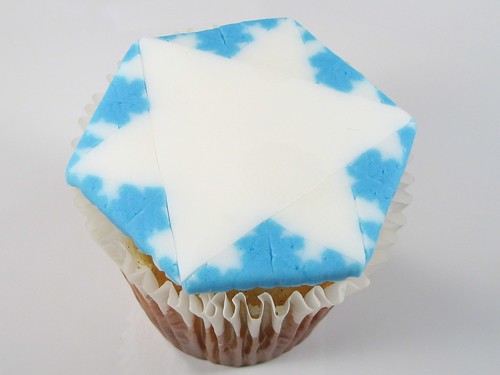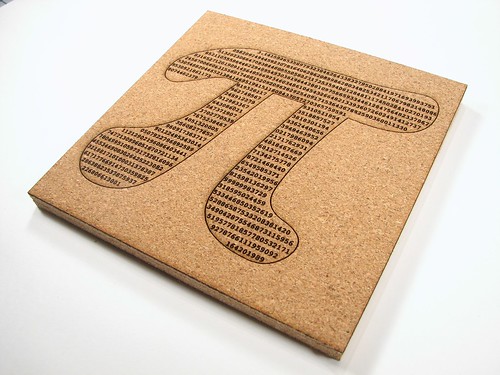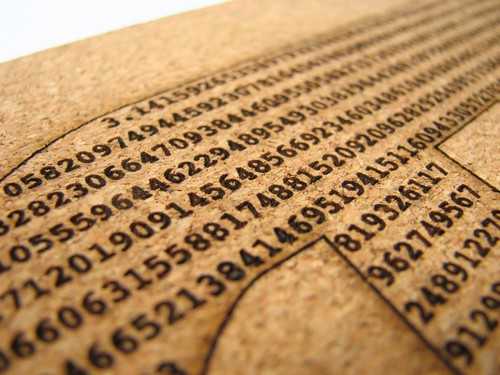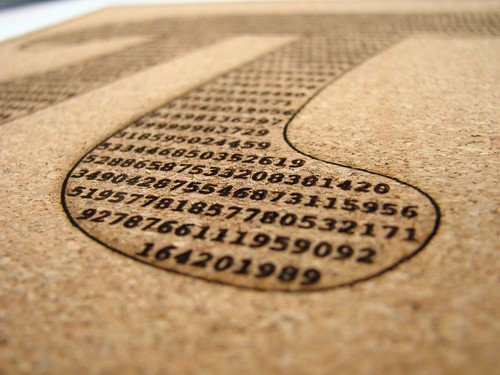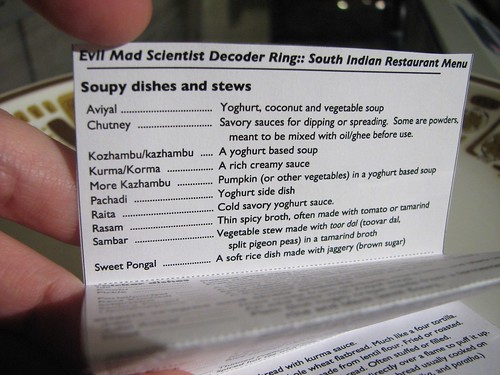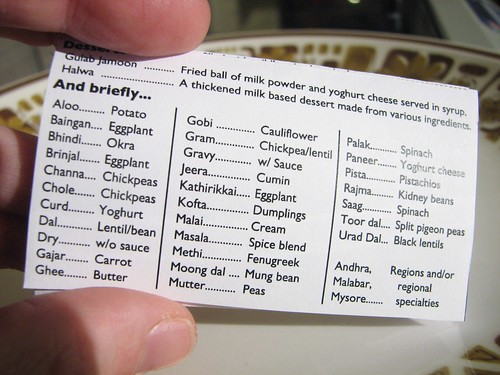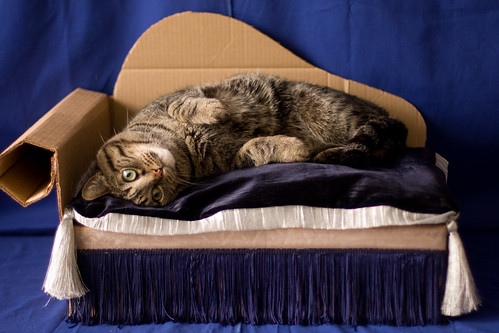The Koch Snowflake is a neat fractal shape… that you can make in your kitchen.
Linkdump: March 2009
- Earth invaders: Röyksopp’s Happy Up Here video (via)
- Manhattan Bridge Construction photo
- Low-cost pancake dispenser
- Coolest Coin Ever (via Core77)
- Help name the new rover! (Vote next week!)
- Recycled coin purse
- Fabric Fractal
- A reminder: “organic” food is silly. And possibly dangerous!
- Skylighter sells some interesting chemicals.
- Read about a scam based on (hilariously) bad math.
- Periodic Table Quilt
- The most reliable debugging method.
- AVR HV Rescue Shield kit.
Pi Pie Trivet
Happy Pi Day! Pi day was just made official. In honor of National Pi Day, we present a pi trivet, perfect for cooling your Apple pie (or pi pie) on.
Besides just the letter pi, The number pi up to the first thousand digits after the decimal are laser engraved into half-inch thick cork. The overall size of the trivet is about seven inches, square.
This cork is actually gasket material from McMaster-Carr, which has a wonderfully smooth and even surface. Compared to many of the other cork materials that we have seen– like that used for many cheap trivets– this has very little pitting and the surface shows fine detail very well.
South Indian Restaurant Menu Decoder Ring
For years, we’ve enjoyed eating out at South Indian restaurants– they often have exceptionally interesting food. They are almost invariably vegetarian, so it is generally safe– even for non-carnivores –to order anything off of the menu.
But here’s the rub: the menus tend to be terse. Many of them have only a list of items, without description at all (Tirupathi Bhimas has an excellent example). It’s not clear if this is because they don’t expect “outsiders” to want this kind of food, or perhaps some other reason, but restaurants with clear descriptions of the menu items are the exception, not the rule.
Moreover, the waiters aren’t always trained to give explanations to non-Indians. If you ask what the difference between a dosa and a rava dosa is, you might hear that rava dosas are crispier. But your waiter may not know that rava means wheat or be able explain that in a rava dosa semolina replaces the rice flour. And that won’t help you if you don’t already know that a dosa is a large crispy crepe made with a fermented batter of rice flour and ground lentils. The semolina in a rava dosa does make it crispier, and a little thicker than a regular dosa. It also takes a little longer to cook, so you can expect it to come out of the kitchen a bit later than a regular dosa.
That little bit of trivia may stick in your mind for a short while, but will you remember it the next time you are at the restaurant? (Will we?) And what if you can’t remember what uthappam is? Some restaurants include more information on their website than they do on their printed menu (Saravanaa Bhavan [pdf] and Udupi Palace are good examples) but it would be a hassle and require planning to print out their online menu to take with you.
So you need a decoder ring! Or at least a wallet card. With a little help from Wikipedia (check out their page on curry!) and the glossary in my copy of 1000 Indian Recipes, we’ve put together a South Indian Restaurant Menu Decoder Wallet Card (800 kB PDF) for your enjoyment, education, and dining pleasure. You can print it out– single sided so no hassle –and it compresses to standard business card size: 3.5″ x 2″. You can also not print it out, and just view it on your iPhone. (And if you’ve never been to a South Indian place, isn’t this a good time to try one?)
A note on spelling and vocabulary: India is big. Many ingredients and dishes have different names in different regions, languages and dialects. Spellings vary a lot. I have used some of the more common variants, and tried to use multiple versions where the variance seems significant to me. I used versions that I have seen on menus in my area. I have not included all of them. If it sounds similar, it probably is.
A note on my definitions: I tried to include enough information to be useful, not so much as to be tediously accurate. My translations are gleaned from lots of sources, including my own experience and experimentation. Space considerations for the wallet card have led to some compromise on absolute accuracy. But I’m not Indian or I wouldn’t be writing this, so if you see something that’s blatantly wrong, please let me know.
We’d love to see wallet decoder cards for other kinds of restaurants, so let us know if you make one! Korean? Pakistani? Where else do we need one?
Giant seven segment displays
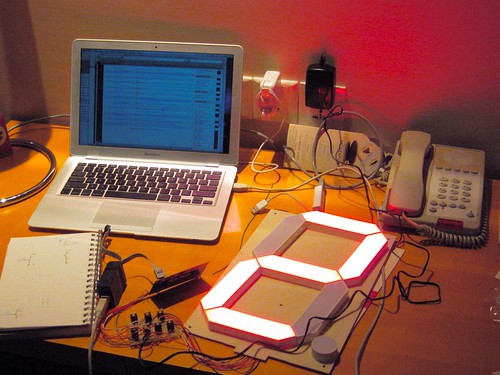
As part of the China trip last week, we had a little scavenger hunt, where the challenge was to build something with parts and tools acquired at the electronics markets.
Here’s what I found: a single-digit seven-segment LED display with twelve inch digit height. (Whoa!)
Continue reading Giant seven segment displays
A visit to the electronics markets of Shenzhen
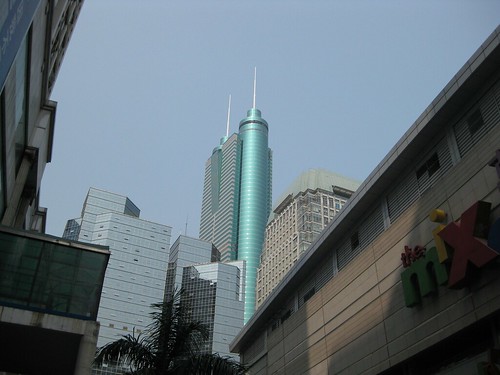
I’ve just returned from a week long trip to Shenzhen, China in a “geek tour” trip organized by Bunnie Huang, with some assistance from the fine folks at PCH International.

More than just a tour, this was also a tiny conference of open source and physical computing hardware hackers.
The participants were (from left to right above): Jeevan Kalanithi, Eric Schweikardt, Bunnie Huang, Nathan Seidle, Leah Buechley, myself (Windell Oskay), Tom Igoe, and David Merrill.
(Thanks to Tom Igoe for the photo. Thanks also to Dale Dougherty for helping to get such a great set of folks in contact for the trip!)
Shenzhen is a vibrant, bustling, young, and modern city of 8 million in southern China. Just across the border from Hong Kong, Shenzhen and the region around it comprise one of the most active and important manufacturing centers in the world today. (Hint: “made in China” sounds familiar.) The city itself is filled with people, restaurants, smog and shiny skyscrapers. At night freakishly large LED billboards illuminate the sides of apartment buildings and animated RGB neon displays ripple above nightclubs and bars. With a few more flying cars, it might do a good impression of Blade Runner‘s Los Angeles.
For me personally, one of the most interesting parts of this trip was spending some time in the vast electronic markets of downtown Shenzhen. The building pictured above, the SEG Electronic Market, is a focal point in the markets. Bunnie wrote quite a bit about this place two years ago (and it’s all true).
Continue reading A visit to the electronics markets of Shenzhen
Fabric Klein Bottle
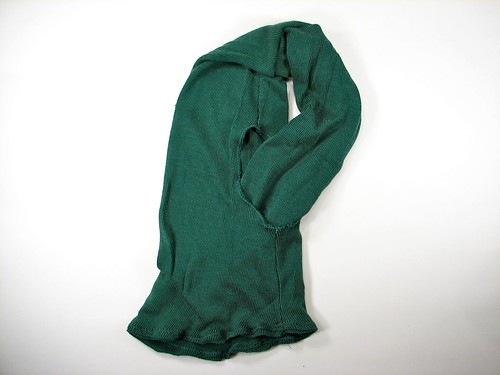
Klein bottles are an entertaining mathematical idea–a shape with no volume. A Klein bottle is basically a tube where the inside is connected to the outside. Making a Klein bottle in our 3D world requires a bit of cheating to work, by adding a hole in one of the walls of the tube to provide a place for an intersection.
The most common physical realization is a glass Klein bottle, which you can ogle and buy at Acme Klein Bottles. They also sell wonderful knit Klein bottle hats which can be bought with a matching mobius strip scarf. I was lucky enough to be given a set as a gift, and it is cozy and bright and wonderful. My only complaint is that the narrow neck of the Klein bottle makes it hard to pull it inside out (or right side out, since it is the same thing) to play with it.
I have found that the concept of a mobius strip is more understandable when you can hold it in your hands and turn it around and around, and I thought the same would be true with a Klein bottle, if only it were a little more flexible than my hat. With that in mind, here’s how to make a simple fabric Klein bottle you can play with from two sleeves of a worn out shirt. Continue reading Fabric Klein Bottle
Cardboard Cat Chaise Roundup
photo by Caitlin Burke
Lots of folks have been making our cardboard cat chaise to mollify their feline companions, so we thought it was about time for a round up.
- abehman made one and painted it red to complement Alowishus’ lovely shade of grey.
- Blog of Fun padded theirs with The Kid’s favorite bath mat.
- scottb12t3 on flickr caught Toby using his.
- odyniec.net used this as an excuse to make a unit conversion script since he prefers metric (can’t blame him).
- Empty-handed‘s chaise clearly got immediate use.
- Caitlin not only put Mr Bun’s chaise on Thing a day, but also augmented it with the tasseled cushion you can see in the photo above.
If I missed yours, drop me a note in the comments. And if you make one, we’d love to see it in the flickr auxiliary!
Update: Here are more:
- From flickr user eugenesucks in the auxiliary
- From James in the comments below
Bristlebots by Klutz?
Some of our friends went to the NY Toy Fair (check out Make’s coverage— it looks like it was a lot of fun!) and came across a new offering from Klutz: “Invasion of the Bristlebots.” We were never contacted by Klutz (or Scholastic), which we find surprising, being that we are the instigators of the current brush-based vibrobot movement, and the coiners of the term bristlebot. Here’s our original story from 2007: Bristlebot: A tiny directional vibrobot. And here’s a round-up of some of the amazing reaction from the DIY community to this news from the toy fair:
- DVICE
- Make
- Make 2
- Make 3
- engadget
- Indie Craft News
- Hack a Day
- Popular Mechanics
- Kim’s Play Place
- CrunchGear
- cnet
- cnet 2
- Coolest Gadgets
- Geeks are Sexy
- Geeks are Sexy 2
- Boing Boing
- mental_floss
- Publisher’s Weekly
- techdirt
- Quill & Quire
Thanks to all of you for your support! We’re still figuring out how to react to this, and we’re waiting for comment from Klutz and Scholastic. We’ll try to update this post as additional stories and information arise.
Update: I’ve been adding news links above, and here’s the official statement from Klutz:
Update 2 (Feb. 20, 12:53pm PST): I just got off of a good phone conversation with Klutz and we’re exploring how we can get acknowledgment for Evil Mad Scientist Laboratories.
Update 3 (Feb. 20, 4:45pm PST): Pat Murphy of Klutz will be sending out a note shortly to let everyone know that Evil Mad Scientist Laboratories will be receiving acknowledgment in the next printing of Invasion of the BristleBots as well as on the Klutz website. This is good news for us, and it seems like Klutz is really learning from this experience about how to work with the maker community. The online response to this situation has been overwhelming and I am glad that such an incredibly vibrant discussion was able to take place. I am truly impressed by and grateful for the support we have received.
Update 4: Here’s Pat’s note:
More Message Hearts
Some folks out there got a chance to try out our message heart cookies in time for valentine’s day. Some were successful, right down to the oversized sweethearts box. Some not so successful, including a convoluted story of trials and tribulations. If you try out one of our projects, we’d love to hear about it and see your photos in the flickr auxiliary.




